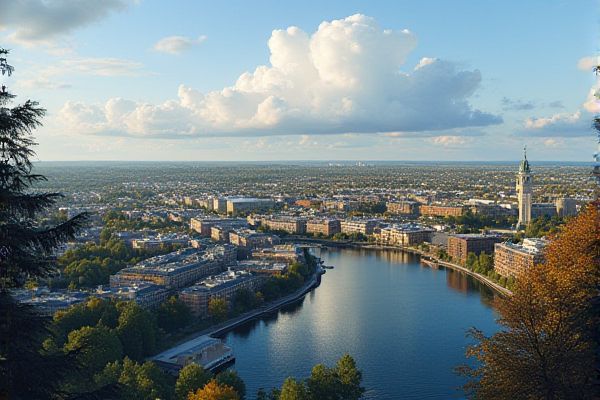
Dining and food culture in Finland: Punctuality is valued. Buffet-style breakfasts are common. Coffee culture is strong. Sweets like pulla are popular. Dairy products are abundant. Rye bread is a staple. Reindeer meat is a delicacy. Fish, especially salmon, is prevalent. Seasonal eating is practiced. Ingredients often locally sourced.
Punctuality is valued.
In Finland, punctuality is an essential aspect of dining and social interactions, reflecting a deep respect for others' time and a strong sense of efficiency. Guests are expected to arrive on time, as this is highly valued both in business and social settings. Finnish people are known for their strict adherence to schedules, whether dining at home or in restaurants. This emphasis on punctuality underlines the broader cultural values observed in Finnish society. To gain deeper insights into these cultural practices and more about Finnish customs, you can consult the Finland Guide available online.
Buffet-style breakfasts are common.
In Finland, breakfast is often enjoyed buffet-style, especially in hotels, where an array of options such as boiled and scrambled eggs, rye bread, butter or margarine, cheese, cold cuts, and vegetables are available, accompanied by a generous amount of coffee. These breakfasts frequently highlight open sandwiches with savory toppings and sometimes include porridge or yogurt, embodying the Finnish focus on a nutritious and filling start to the day. For more insights into Finnish morning meals, you can visit Feels Like Finland for a deeper exploration.
Coffee culture is strong.
In Finland, Coffee Culture is deeply embedded, with Finns consuming nearly four cups of coffee per day. They have a strong preference for light roast filter coffee, and it is integrated into all aspects of daily life. Mandatory coffee breaks at work and social gatherings are a norm, where even silence is acceptable and refusing a cup is considered rude. To delve deeper into this fascinating cultural phenomenon, one can explore more insights on the Finnish Coffee Culture and its significance in Finnish society.
Sweets like pulla are popular.
Pulla, a traditional Finnish sweet bread, is highly popular and known for its cardamom flavor and braided appearance, often enjoyed with coffee or tea and a favorite during holidays. It combines the richness of Brioche and the visual appeal of braided Challah, making it a staple in Finnish cuisine. For those interested in baking this delightful bread, the Finnish Cardamom Bread Recipe offers a detailed guide to recreating this classic treat at home.
Dairy products are abundant.
Dairy products are a cornerstone of Finnish food culture, with Finns consuming one of the highest amounts of milk per capita in the world, approximately 130 litres per person annually. Popular dairy products include *piima* (sour milk), *viili* (curd milk), *rahka* (fermented milk product), and *leipajuusto* (Finnish squeaky cheese), along with a wide range of yogurts, cheeses, and low-lactose or lactose-free variations. To learn more about this fascinating aspect of Finnish life, visit the Finish Dairy Food page and delve into the rich tradition of dairy in Finnish cuisine.
Rye bread is a staple.
Rye bread is a cultural and nutritional cornerstone in Finland, with a history dating back over 2,000 years. It is made from simple ingredients like rye flour, water, and salt, and its long fermentation process gives it a distinctive sour, tangy taste and high fiber content, making it a staple in every Finnish meal. For more insights into this timeless tradition, visit the Finnish Rye Bread story that showcases how this cherished bread transcends borders and generations.
Reindeer meat is a delicacy.
Reindeer meat in Finland is a delicacy known for its fine texture, tenderness, and low fat content, making it a sought-after choice for many food enthusiasts. Popular dishes featuring this meat include Sauteed Reindeer (Poronkaristys), reindeer steaks, and cold smoked reindeer, each offering a unique culinary experience. These dishes are highly valued not only for their distinctive game taste but also for their nutritional benefits. If you're interested in exploring more about this delightful Finnish cuisine, you can learn more at Bucket List Publications. Whether you are visiting Helsinki or simply curious about international delicacies, reindeer meat stands out as a must-try for its rich flavors and cultural significance.
Fish, especially salmon, is prevalent.
In Finnish Cuisine, fish, particularly salmon, is a significant protein source, with various preparation methods such as frying, boiling, drying, salting, fermenting, and cold smoking. Salmon is popular in dishes like *lohikeitto* (salmon soup), *kylmasavustettu lohi* (cold smoked salmon), and *graavilohi* (gravlax).
Seasonal eating is practiced.
In Finland, seasonal eating is deeply ingrained, with each season offering unique ingredients and dishes, such as new potatoes and berries in summer, mushrooms and game in autumn, and hearty root vegetables and meat casseroles in winter. This culinary tradition reflects the country's harsh climate and natural bounty. For more insights into Finland's culinary landscape, visit the Eat Finland website.
Ingredients often locally sourced.
Finnish cuisine is characterized by a strong focus on locally sourced ingredients, emphasizing fresh flavors from the country's geography, including seafood, root vegetables, wild berries, and wholemeal products like rye, barley, and oats. To learn more about the fascinating food culture and delicious dishes of Finland, you can explore further on the Work in Finland website, which offers extensive insights into the nation's culinary scene.
